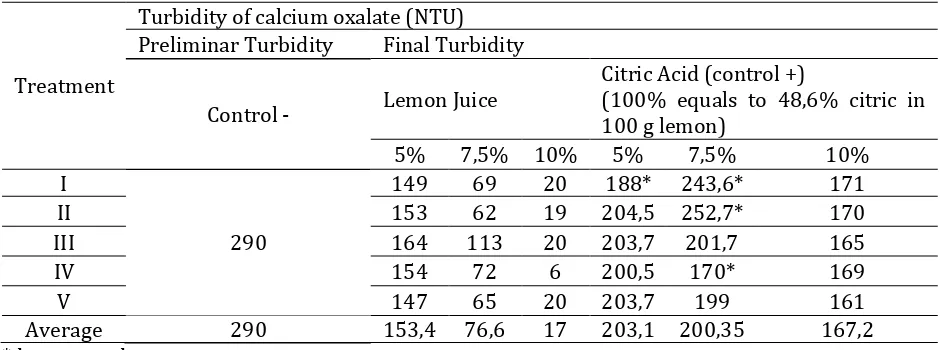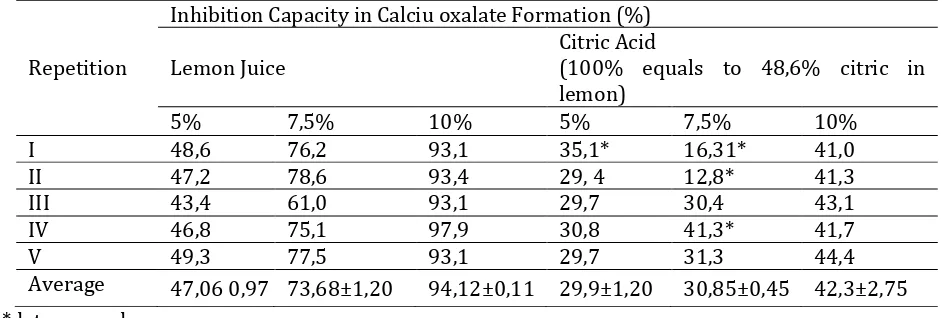Available online at http://journal.walisongo.ac.id/index.php/jnsmr
In Vitro Inhibition Capacity in
Ca Oxalate
Formation by Lemon (
Citrus
Lemon
) Juice
Endang Tri Wahyuni Maharani1, Jatmiko Susilo2, Arifiani Agustin Amalia3
1Diploma Program of Health Analyst Faculty of Nursing and Health Semarang Muhammadiyah University, Central Java, Indonesia
2Undergraduate Program of Pharmacy STIKES Ngudi Waluyo Semarang 3Diploma Program of Health Analyst Semarang Muhammadiyah University
Corresponding author:
[email protected] Recived: 3 Nopember 2015, Revised : 25 November 2015 Accepted: 20 December 2015.
Abstracts
This research aims to determine the inhibition capacity of lemon juice (Citrus lemon) in the formation of calcium oxalate in a variety of concentrations of 5%, 7.5%, 10% which is then compared to pure citric acid. Lemon juice contains citric acid that can inhibit calcium oxalate’s formation. Inhibitory activity found in lemon juice is examined by observing its inhibition capacity towards the formation of calcium oxalate crystal. At the end of the treatment process the turbidity level is compared to citric acid acting as an inhibitor in the formation of calcium oxalate and then the percentage of the inhibition capacity is calculated. Result of the study shows that the optimum concentration of the lemon juice (Citrus lemon) and citric acid is 10%. The inhibition capacities in calcium oxalate formation by lemon juice with concentration variations of 5%, 7.5%, 10% are 47.06%, 73.68%, 94.19% and by citric acid with concentration variations of 5%, 7.5 %, 10% are 29.90%, 30.85%, 42.30%. It can be concluded that the higher the concentration of lemon juice and citric acid used the higher the inhibition capacity of calcium oxalate. Based on the inhibition capacity percentage, lemon juice is more effective in inhibiting the formation of calcium oxalate compared to citric acid and it can function as an alternative to prevent the formation of kidney stone. © 2015 JNSMR UIN Walisongo. All rights reserved
Key words: Inhibition Capacity; Lemon Juice,; Citric Acid.
1.
Introduction
Kidney stone is small solid materials formed in the kidney as a result of deposition happening in the urine moving down to ureter.
Kidney stone is formed because of crystalized urine, kidney acidity abnormality, and the decrease in the crystal forming kidney stone calcium is inhibited by flavonoid, potassium, magnesium, and citric acid [1].
Lemon (Cytrus lemon) is a fruit commonly grown in Indonesia. It has low glucose level and tastes sour because it contains citric acid. The level of sourness in the fruit is the result of the high citric acid level. Citric acid is an organic compound in a form of crystal that is colorless, odorless, sour, and easily dissolved in water or alcohol. The citric acid level in lemon juice is 48,6 g/kg. Citric acid is beneficial to prevent the forming of kidney stone. Citric acid in oranges is known to be able to break down several substances namely sulfate, phosphate and natrium that can potentially form kidney stone causing kidney faliure [3].
Kidney stone or calcium oxalate is formed because of hipositraturia factor in the urine, a pocess in which citric acid reacting with calcium forming calcium citrate that blocks the bonding between calcium and oxalate or phosphate. It is possible because calcium citrate is more easily dissolved compared to calcium oxalate. Therefore, citric can function as inhibitor to the forming of calcium stone. The chemical reaction is as follows:
Calcium oxalate + Citric acid Calciun Citrate + Oxalic acid
Several studies have been conducted upon the dissolvance effect of kidney stone, especially calcium stone, by using traditional herbs namely: radish (Rhapanus sativus), kidney stone by lemon juice eventhough lemon is commonly found in our society. Based on the above reason, a study on the in vitro inhibition capacity in calcium oxalate formation by lemon juice is conducted.
2.
Experiments Procedure
The study is using experimental,
comparatian and factorial researches, a research method conducted with the purpose of testing a certain research object to compare the concentration of lemon juice and citric Each sample treatment is repeated five times.
3.
Result and Discussion
Tabel 1. Turbidity in calcium oxalate formation by lemon juice and citric acid.
Turbidity in Ca Oxalate Formation (NTU)
Control
Result of the preliminary test is to find te lemon juice concentration that has the closest outcome to citric acid acting as the positive control. Based on the result shown in Table 1, the inhibition capacity of 5% concentration reaches the percentage capacity of 5% citric acid, meaning that 5% concentration of lemon juice can inhibit the formation of calcium oxalate, therefore 5% concentration is used as control to determine the concntration applied in the research test. The 25% concentration shows negative result which is most likely to be invalid because the device might be unable to detect the turbidity, thus this concentration level cannot be applied to be the control in the research test. The applicable concentration levels in this research are 5%, 7,5% and 10%. Solution of CaCl2 and H2C2O4 are devided into
7 groups and given different treatments. The first group is not given the lemon juice or
citric acid on the CaCl2 and H2C2O4 solutions to
act as preliminary turbidity value. The second to fourth groups are given lemon juice with well. Citric acid used in this study acting as the positive control is an active substance proven to be effective in dissolving calcium oxalate resulting in the inhibition of kidney stone formation.
Table 2. Estimation on lemon juice and citric acid concentration towards the formation of calcium oxalate
Treatment
Turbidity of calcium oxalate (NTU) Preliminar Turbidity Final Turbidity
Result in Table 3 shows that lemon juice has inhibiting effect towards the formation of calcium oxalate. This fact is coherent with the preliminary hypothesis stating that lemon juice concentration affect the formation of calcium oxalate. The inhibition capacity in calcium oxalate formation is shown in the average percentage of calcium oxalate inhibition. It also shows that the higer the lemon juice concentration, the higher the inhibition of calcium oxalate formation. One way ANOVA test is used to acknowledge
wether there are differences in the average percentage level of inhibition in the seven groups given the treatment. The result is significant, with α < 0,05 showing that lemon juice and citric acid has different effects on every concentration level in inhibiting the formation of calcium oxalate. Tukey test difference towards the effectiveness of inhibition capacity in the calcium oxalate formation.
Table 3. Percentage of inhibition capacity in calcium oxalate formation by lemon juice and citric acid.
Repetition
Inhibition Capacity in Calciu oxalate Formation (%)
Lemon Juice
Average 47,06 0,97 73,68±1,20 94,12±0,11 29,9±1,20 30,85±0,45 42,3±2,75
*data unused
Based on Table 3, lemon juice has more effective inhibition capacity in calcium oxalate formation compared to citric acid. The study shows that lemon juice (Citrus lemon) can be used as an alternative solution to cure kidney stone. Further study to know the toxixity level on certain concentration levels using different methods is necessary. The turbidity is affected not only by calcium oxalate formation but also by the turbid lemon juice. It can be concluded that turbidimetry method is incompatible to test the lemon juice because the turbidity value is not purely derived from the reaction formed.
4.
Conclusion
Acknowledgment
The author wish to Program of Health Analyst Faculty of Nursing and Health
Semarang Muhammadiyah University,
Program of Pharmacy STIKES Ngudi Waluyo Semarang, for support in this research.
References
[1] A.W. Sundoyo and B. Setiyohadi, Buku Ajar
Penyakit Dalam, 4th Edition. PP
Departemen ilmu penyakit dalam.
Jakarta, 2006.
[2] J.B. Cahyono and B. Suharjo. Hepatitis A. Edisi 1 . Yogyakarta: Kanisius, 2009.
[3] M. Astawan, A.L. Kasih, Khasiat Warna-warni Makanan. PT Gramedia Pustaka Utama, member of IKAPI, Jakarta, 2008. [4] Suparmi. Makna Pendampingan Spiritual
pada Asuhan Keperawatan Pasien
Preoperasi di PK Sint. Corolus Jakarta.
Thesis. Universitas Indonesia Jakarta, 2008.
[5] Purwaningrum dan kadarsih, Efek Sari Lobak (Raphanus sativusL.) Terhadap Kelarutan Batu Ginjal Kalsium Secara In
Vitro. Skripsi. Fakultas Farmasi
Universitas Indonesia, Jakarta , 2005. [6] Kurnia, E. dkk., Penelitian Daya Larut
Daun Spesies-spesies Sonchus dan Empat Jenis Tumbuhan kejibeling Terhadap
Beberapa Batu Kalsium. Prosiding
Simposium Tanaman Obat I. Bagian

